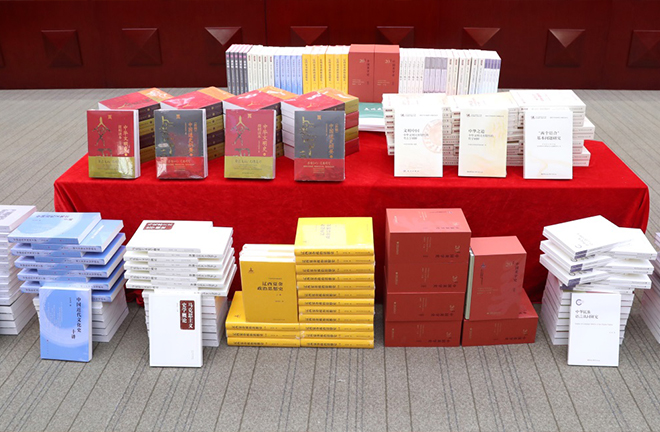CASS unveils new outcomes on building modern Chinese civilization

Research works displayed at the conference Photo: Zhu Gaolei/CSST
On May 27, the Chinese Academy of Social Sciences (CASS) convened a press conference in Beijing to unveil a second batch of major outcomes related to the research and interpretation of the building of a modern Chinese civilization.
June 2 marks the first anniversary since General Secretary of the CPC Central Committee Xi Jinping visited the Chinese Academy of History (CAH) under CASS, where he attended a seminar on cultural inheritance and development and delivered an important speech calling for efforts to build a modern Chinese civilization.
Emphasizing this landmark event in the development history of CASS and of philosophy and social sciences in new China, CASS Vice President Zhen Zhanmin stated in his speech at the conference that, over the past year, CASS has initiated a project dedicated to researching and interpreting modern Chinese civilization. This project has made remarkable progress by unifying its political and academic nature, and integrating its inherent thoughts and knowledge, through coordinated research endeavors.
The conference released 22 significant research works consisting of 12 books and 10 theses.
Li Guoqiang, deputy director of the CAH, offered a brief introduction to A New Compendium of the General History of China (2 Volumes) and A Concise Reader of the History of Chinese Civilization (2 Volumes). He described these books as key milestones in the project to compile a new general history of China. With national unification and social development as its main thread, the former work focuses on pivotal changes and periods in Chinese history to underscore its major currents, pathways, and trends. The latter, drawing on the latest findings from historical and archaeological research in the new era, chronologically delineates the evolution and outstanding achievements of Chinese civilization, offering a straightforward explanation of the law of its historical evolution.
According to Xin Xiangyang, director of the Academy of Marxism at CASS, Research on Basic Issues of ‘Two Integrations’ zooms in on the original contributions of Xi Jinping Thought on Culture, the CPC’s leadership over cultural work, and the building of an advanced socialist culture. It discusses in depth vital issues such as the relationship between the integration of Marxism with China’s specific realities and its integration with fine traditional Chinese culture. The book also explores the subjectivity of Chinese culture, the creation of a new, organically unified cultural entity, and the way to write a new chapter on adapting Marxism to the Chinese context and the needs of the times, and build a modern Chinese civilization.
The Chinese Way: A Philosophical Interpretation of Chinese Civilization’s Prominent Features examines the profound implications of the five prominent features of Chinese civilization (continuity, innovativeness, unity, inclusivity, and peaceful nature). Zhang Zhiqiang, director of CASS’s Institute of Philosophy, stressed that systematically understanding the intrinsic relevance and theoretical relationships among these five prominent features is essential to comprehending the core values of Chinese civilization.
According to Zhang Guochun, deputy director of the Institute of Archaeology at CASS, Civilized China: An Archaeological Interpretation of Chinese Civilization’s Prominent Features substantiates the five prominent features of Chinese civilization through archaeological discoveries and research output over the past 100 years. It deciphers the inherent qualities and formation paths of each feature, attempting to reveal the symbiotic relationships among them and the internal mechanisms that have driven the evolution of Chinese civilization.
The 20th century saw China, alongside Chinese aesthetics, undergoing modernization, observed Gao Jianping, a research fellow from CASS’s Institute of Literature. Constructing theories on Chinese modernization entails a review of Chinese modernization in the 20th century, and A History of Chinese Aesthetics in the 20th Century reflects on the modernization drive in the field of aesthetics.
Shi Weimin, a research fellow from the Institute of Political Science at CASS, remarked that the evolution of political thinking in dynasties or kingdoms established by ethnic groups shouldn’t be overlooked in the historical course of ancient Chinese political thought. The History of Political Thoughts in the Liao, Western Xia, and Jin Dynasties (3 Volumes) elaborates on the Confucianization of political thought in the Liao Dynasty, the Buddhist orientation of political ideas in the Western Xia, and the Jin’s advocacy for civil rule in political thinking.
“Language is a carrier of culture, and characters are symbols of civilization,” said Zhang Jun, an associate research fellow from the Institute of Ethnology and Anthropology at CASS. In the book Studies on Language Identity of the Chinese Nation, Zhang emphasized the significant historical and contemporary impacts of language and characters on the formation and development of the Chinese nation, as well as on fostering a sense of community for the Chinese nation. Studying Chinese language and characters, along with the language identity of the Chinese nation, requires an understanding of the uniqueness of Chinese civilization from cultural and institutional dimensions, he added.
Edited by CHEN MIRONG
